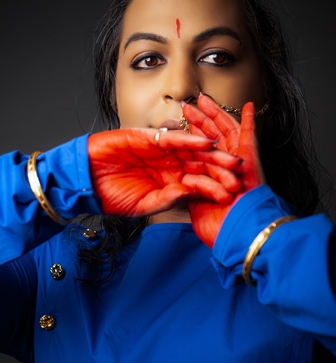Words by Katie Hagan. Jaivant Patel Dance‘s bill YAATRA performed at the Blue Elephant Theatre, London.
Walking into the Blue Elephant’s performance space, we were greeted by what appeared to be hanging light bulbs lingering in the hazy darkness. Yet as the room came to life when choreographer Jaivant Patel entered the space, the suspended light bulbs transformed into bells which Patel gently brushed to release their bodied chime.
Either I was deceived by the illusion or I misjudged what was in front of me. Regardless, this visual image serves as a metaphor for Jaivant Patel Dance’s bill YAATRA. Now touring nationally, YAATRA makes us question the traditions society is built on and the illusions they perpetuate.
Both pieces, AWAKENING and YAATRA, are an amalgamation of Kathak, contemporary choreography, music and spoken word. Conceptually, AWAKENING explores gender fluidity in traditional Indian narratives, with YAATRA debating what it means for a homosexual Indian man to enter a place of worship.
In AWAKENING Patel is beguiled by another being, the Hindu deity Krishna. He dances for the person he admires, with deft footwork, coy eyes and inviting arms. There is perfect synergy between the movement and music, with bells on the ankles paralleling the hanging bells Patel chimes.
Patel’s snake-like shapes and contractions are an ode to both metamorphosis and role-playing in classical Indian myths. Patel highlights the paradoxes in religious discourses, questioning why Hindu deities can be non-binary without judgement, when modern mortals face marginalisation for their sexualities and ‘controversial’ attitudes.
Whilst on the surface AWAKENING is a beautiful exhibition of unblemished love and innocence, underneath it is a provocative tale of sexual discovery and religious hypocrisy. YAATRA continues in the same strain but with more pain — which is a strange welcome in comparison to the starry-eyed AWAKENING.
Similar to AWAKENING in the sense it is a narrative-heavy piece, it differs by fusing contemporary dance with Kathak. Traditionally, Kathak is characterised by plenty of neat feet, delicate hand movements and facial expressions all signifying emotion or action. In YAATRA Patel plays on tradition, moving away from gesture to incorporate contemporary sweeps and rolls which articulate his struggle to fully express himself as a homosexual man of faith in a place of worship.
Ritualistically removing the bells from his ankles, Patel takes items from a bag he carries — beads, an icon and a banana — modelling a mini shrine in front of him. He admires them all, treating each with reverence. He eats the banana and looks into the audience, yet his teasing look is wiped from his face when he realises he is being judged for this hyper-sexualised, erotic act. Disdained for eating a banana in his place of worship, Patel is displaced and alienated by those who seek to stereotype.
YAATRA works very well as a bill, as the two pieces are conceptually, choreographically and aesthetically different. YAATRA has a weightier, well-rounded narrative in comparison to AWAKENING which teeters on being too much of a show or demonstration of a concept rather than an immersive exploration. Conversely, in YAATRA you feel Patel’s anguish and frustration as you witness him wrestling with his faith and sexuality — an unconquerable battle which he performs with dignity. Â
As a dance artist, LGBTQ+ and south Asian homosexual, Patel is refreshingly unique. The inconceivable relationship between religion and homosexuality in Patel’s YAATRA is a first for dance within our global culture. Instead of a cryptic condemnation of the past, Patel critiques tradition through reinvention. A careful layering of traditional Hindu narratives with contemporary dance, poetry and song, YAATRA is a joyous bill which reminds us there is beauty in the fluidity of our identities and strength in our non-conformance to the stereotypes society wishes to impress upon us.Â
Image Jaivant Patel.
